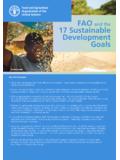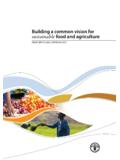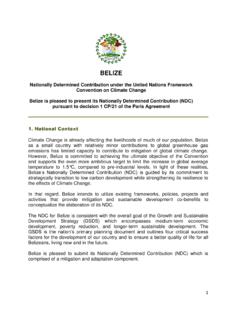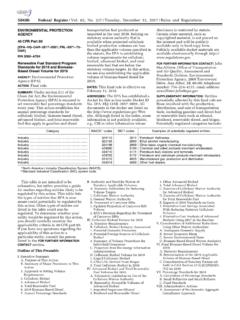Transcription of Biogas as Renewable Energy from Organic Waste
1 UNESCO EOLSSSAMPLE CHAPTERSBIOTECHNOLOGY Vol. X -- Biogas as Renewable Energy from Organic Waste - Amrit B. Karki Encyclopedia of Life Support Systems (EOLSS) CBIOGAS AS Renewable Energy FROM Organic Waste Amrit B. Karki Consolidated Management Services Nepal (P) Ltd, Kathmandu, Nepal Keywords: Renewable Energy , Organic residue, Anaerobic digestion technology, MSW, Effluent Contents 1. Introduction 2. Biomass Waste Plant Waste Animal Waste Human Waste 3. Energy production using anaerobic digestion technology Biogas Technology Biogas Potential Characteristic and Composition of Biogas Designs of Anaerobic Reactors Conditions for Anaerobic Fermentation Process of Anaerobic Fermentation for Methane Generation Use of Biogas Implications of Biogas System 4. Energy from Garbage and Municipal Solid Waste Concept and Options for Treating the Municipal Solid Waste Anaerobic digestion of municipal solid Waste [MSW] 5.
2 Energy from Human and/or Animal Waste Case Studies Latrine-attached Bio-digesters Bio-digester Fed with Latrine Waste and Elephant Dung at Machan Wildlife Resort Chitwan, Nepal Bio-digester fed with Sewerage, Kitchen Waste and Lawn Grasses Glossary Bibliography Biographical Sketch Summary Biomass comprises mainly trees and plant wastes (eg. wood, saw dust, leaves, twigs), agricultural residues, animal and human Waste , coal etc. These wastes of plant, animal and human origin are the resources that yield valuable Energy and fertilizer. Bio-residues (dung from animal, different types of crop residues such as rice straw, wheat straw, maize stalk, leguminous plant and weeds, aquatic plants) are already widely used in some countries. One of the best options would be to treat the biodegradable wastes into an anaerobic digester in view of producing environmentally sound Energy as well as biofertilizer.
3 Fuelwood resources which represent 78 percent of Energy consumption are mainly UNESCO EOLSSSAMPLE CHAPTERSBIOTECHNOLOGY Vol. X -- Biogas as Renewable Energy from Organic Waste - Amrit B. Karki Encyclopedia of Life Support Systems (EOLSS) consumed in rural Nepal. They are depleting very fast due to over exploitation and lack of proper management. Other biomass sources, agricultural residues and animal Waste , provide for about 10 percent of Energy requirement. Imported petroleum and coal together make about 11 percent of the total consumption. The methane bacteria are abundantly found in the marsh or swampy land, rumen of animal, Waste water, etc. They develop very slowly and are affected by a sudden change in their environment. Methane, which burns with a clear blue flame without smoke, is non-toxic and produces more heat than kerosene, wood, charcoal, cow-dung chips etc.
4 The gas is used for cooking, lighting and to run electric motors, irrigation pumps, refrigerator and compressors. Common uses of Biogas as Energy source in the context of developing countries are for cooking and lighting, while other uses are limited. The technology of production of Biogas has become quite popular in the developing countries especially in China, India and Nepal. Although Biogas technology was first introduced by a school teacher around 1955 in Nepal, as many as 150,000 family size Biogas plants have been established by 28 June 2006 due to concerted efforts of many governmental and non-governmental organizations. It is worth mentioning that among the various actors, the role played by Biogas Support Programme (BSP) created under the framework of the Netherlands Development Organization (SNV) is praise worthy so far as promotion and development of Biogas technology is concerned in Nepal.
5 In December 2003, BSP was transformed into an autonomous Non-Government Organization (NGO) called Biogas Sector Partnership-Nepal (BSP-N). Popularization of Biogas technology has relieved the women from drudgery of cooking with firewood which produces hazardous smoke. The Biogas potential is generally based upon the cattle population and quantity of dung actually collected from these animals. Based upon cattle population, there is the potential to produce 673 million m3 of Biogas annually (equivalent to 4038 GWh in terms of hydropower) or has the potential to substitute 390 million litres of kerosene. Nepal has a potential of establishing million family size (8 to 10 m3) Biogas plants. Various designs of anaerobic reactors ( Biogas plants) have been used both in the developed and developing countries of the world.
6 The main designs that are of interest are: Floating Drum Digester, Chinese Model Fixed Dome Digester, GGC Concrete Model Biogas Plant, Deenbandhu Model, Bag Digester, Plug Flow Digester, Anaerobic Filter, Anaerobic Filter, Up-flow Anaerobic Sludge Blanket (USAB). Biogas technology is best suited to convert the Organic Waste from agriculture, livestock, industries, municipalities and other human activities into Energy and manure. The use of Energy and manure can lead to better environment, health, and other socio-economic gain. In this context, it is worth to quote the Denmark's example about the technology of production of Energy from refuge. The plant is designed to handle 8 tonnes/hour of Waste which enables treatment of up to 22,000 tonnes year-1. The municipal Waste is collected and brought to Knudmosevaerket. The pre-treated Organic Waste is transferred, in closed containers, to one of the Biogas plants.
7 This fairly solid Waste is then mixed with liquid manure to obtain a liquid solution. This liquid is deactivated at 700 C for one hour and digested at 550 C over a period of 16 days. The UNESCO EOLSSSAMPLE CHAPTERSBIOTECHNOLOGY Vol. X -- Biogas as Renewable Energy from Organic Waste - Amrit B. Karki Encyclopedia of Life Support Systems (EOLSS) total maximum output from the plants supplied with Biogas is Mwe and Mwth. The importance of Biogas as a cost effective source of clean Energy and nutritive Organic fertilizer can not be over emphasized [see also Bio-Refineries]. Because of the traditional use of this technology, little effort is made to explore its possible application to meet Energy requirements of other establishments such as wildlife resorts, refugee campus, schools and hospitals. In this backdrop, CMS initiated a project to install a pilot Biogas plant in one of the wildlife resorts in Chitwan District (Machan Wildlife Resort) utilizing elephant dung.
8 It was envisioned that implementation of this pilot project would provide a base for empirical assessment of the technology for its new use, for proper disposal of elephant dung and to meet a part of the Energy requirement of wildlife resorts. The eight adult elephants at MWR produce a total of approximately 160 kg dung per day (20 kg/elephant/day) which can be used to feeding a Biogas plant. Elephant dung contains high proportion of fibrous materials with a high carbon nitrogen (C/N) ratio of 43. Optimum gas production occurs at around a C/N ratio of 25. The human excreta from the resident employees of MWR and the guests could be used to bring down the C/N ratio of the base feeding material, elephant dung. Therefore use of human excreta which contains a low C/N ratio (8 to 10) in conjunction with elephant dung was suggested for a smooth functioning of the Biogas plant.
9 Although the initial loading of the digester was done with cow dung for quick and easy operation, the digester was operated subsequently with elephant dung and human excreta only. The successful production of methane gas (perhaps the first historical one from elephant dung) was tested on 30th March 1994. The gas was used for cooking the food of the staff and for lighting Biogas lamps. In order to widen the scope of production of fuel ( Biogas as clean fuel) and Organic fertilizer in the country as a whole (see also Biotechnology in Rural Arears), it is imperative to utilize profitably aforesaid sources of biodegradable materials other than animal Waste . In Nepal, there exists a tremendous scope for establishing Biogas plants in large number of institutions, like security offices (barracks), boarding schools, hostels, canteens, prisons, monasteries etc.
10 Where abundant biodegradable wastes such as faecal Waste , food Waste etc are available as input to produce Biogas and bio-manure. In this context, the first pilot bio-digester of 20m3 capacity was installed at Shechen Monastery, located at Boudha, Kathmandu, as a pilot institutional plant to represent the hill condition. This is a new design called TED introduced in Nepal, which is based upon Deenbandhu Model in India. The initial feeding of bio-digester was done with cow dung. After stabilization of gas production, adequate quantity of kitchen Waste , soft grasses, and Waste paper were be added into the bio-digester to continue the gas production in regular manner. Thereafter, the sewerage system was connected to the bio-digester. As the toilets which are utilized by the majority of the monks (150) are currently connected to a sewer line and are equipped with flush system, the digester was integrated in the existing sewer line.
















